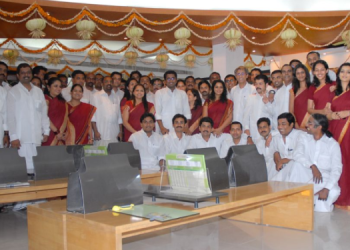In the end of March when the lockdown was announced most organisations went into a WfH mode. There was a feeling of relief and many felt life would be easier with no long hours of daily commute and work pressures. In the beginning life was a party with everybody enjoying the freedom and getting into things they had never had the time before. Things like cooking/gardening etc became the ritual and OTT viewing spiked. As the lockdown entered the second month things changed. Work pressures mounted, time lines blurred and stress started taking its toll.
We also heard of people getting anxiety attacks, many with mental health issues or with a history of depression the conditions got aggravated. This was not just in the Media but across industries.
We spoke to HR heads, a workplace counsellor and others on what is leading to this stress, anxiety attacks and even heart attacks and as organisations what are the remedial measures being put in place for employees to make WFH a much more comfortable and stress free.

Divya Thampi – Emotional Wellness Coach | Workplace Counsellor | Training Consultant
“In this lockdown and WfH doing anything has become far more challenging in comparison to the times before the pandemic. There are no clear cut boundaries, work starts in the morning straight from the bed. People are having difficulties in going to sleep due to constant sense of anxiety as work has not been completed. There is no clarity on when work starts and when it ends. Home has no boundaries and this happens more with women, as she ends up playing multiple roles, she is expected to help out at home and her timelines may not be respected like one does with a man or if there are small kids, then they have to be cared for. This in turn spills over to dissatisfaction in relationships.
Before the lockdown people had an opportunity to go out for work and they spent 8-10 hrs away from home and this also gave them an opportunity to interact with an entirely different set of people in a physically different environment and it had its benefits. There was a routine in the daily life, you finished work and once you got back home you switched off, somedays it continued but there was a closure. There was a difference between who you were spending time with when you were working and at home. There was some amount of socialiasation, you got back from work and spent time with the family. Over and above all, the weekends were something to look forward to and socializing with people who shared your interests, spending time out in the open, whether it was shopping, or dining out or catching a movie and now the socialization aspect in our life’s is completely missing.
All the things which allowed you to unwind and relationships which are such an integral part of our lives as it helps a person to de – stress and in the current scenario nor do you have that extra socialization and to top it up the relationships at home are under stress, generally there is more conflict. It could be a combination of all these facts put together and for people who had been dealing with mental health issues, anxiety issues, or depressive disorders this situation has made it much more difficult and has aggravated the condition.
A few organisations are trying to do things to ease life for their employees and communicate to their employees that they should try and have a clear cut work time and segregate work and me time. But that kind of communication and implementation needs to become more serious. For example, extra day off every week will help in mental health given the circumstances as people have more responsibilities at home as well and making it difficult to work in some cases, this break will come as a blessing to finish off pending chores at home.
Though companies send out communication saying you need to take a break, take your day off but at a departmental level work pressures have increased. Most times employees are feeling disconnected with what the HR is communicating and what their departmental head is communicating to them.
Organisations need to get their act together in implementing the orders. They can do group calls, and it should be a culture which is top to down, and the employees should feel that the leadership is serious about it. Serious about having these boundaries and implementing it in multiple forms like putting in barriers for working on weekends, barriers in working after certain hours of the day and giving those extra few days off. Organisations should have town halls regularly, in smaller groups where you can create a safe place for people to speak about their real time challenges they are dealing with.
These are somethings that organisations need to do and consider as to how they can support employees to have a more comfortable working environment and this will vary from organization to organization. Organisations can invest in basic working facilities like a good Chair or a table, depending on what suits the employee at home.”

Naresh Gupta – Co-Founder and Head Intern at Bang in the Middle
“Work from Home is tough. Actually very tough. We are seeing people working much longer hours as work tends to eat into personal times. We try and chat often with everyone. We do a Friday eve chats with all team members to catch up. We are doing an interesting engagement on Twitter to keep conversation on between all team members. Our twitter handle changes everyday. One new person takes Centre stage and we do social gossip. This becomes a way for people to chill and laugh.”

Vishal Gondal, Founder & CEO, GOQii
“According to our recent survey conducted across 10000+ Indians, 43% of Indians are currently plagued with depression and are learning to cope with it. With 26% Indians facing mild depression, 17% face a more strenuous kind. It is concerning to note that 6% Indians are severely depressed. One of the major reasons for mental health issues is stress and anxiety, as a result of the uncertainty around the current situation. While stress has impacted everybody, working professionals are increasingly anxious and stressed due to the mounting pressure of work and the expectation to balance personal and professional life. In order to combat mental health issues, organisations must encourage lifestyle modifications with physical activity, nutrition and sleep being the major focus. We at GOQii encourage our employees to lead a wholesome and healthy lifestyle, with access to GOQii play videos and mental health and emotional well-being coaches, in case they require one-on-one counselling. Adapting to a healthier lifestyle is the key to keep anxiety and depression at bay.”

Rita Verma, EVP and Head- HR, DDB Mudra Group.
“Firstly, we need to acknowledge that workplace stress is an issue that is plaguing the industry. This is pronounced now with everyone working from home and for many, the line between work and home has blurred. Tackling this issue requires a concerted effort and there are three key parts to it. One is creating a culture of transparency and encouraging people to be a part of this change process. At DDB, we’ve taken some measures to co-opt people and encouraged them to bring forth their ideas and suggestions through forums such as townhalls and candid conversations meets. The other part of this complex issue is institutionalizing change through policies. Policies such as the Employee Assistance Program which provides free mental health counselling for all our people, compulsory leave to help them switch off and tools like Asana and Sunday Trackers aim to maximise productivity and safeguard time. This brings me to the third aspect, which is bringing our clients into these conversations, and encouraging mutual respect for each other’s time. Honestly, these are only the first few steps in all that we have to do.”

Roopa Badrinath, Chief Talent Officer, Wunderman Thompson, South Asia
“When Work from Home began sometime in the month of March there was palpable excitement about the novelty of the concept laced with a certain amount of trepidation about how it would pan out. Some were worried about the efficacy of the client deliverables while some about their own productivity in addition to their team members productivity levels. Once the initial glitches were ironed out and a certain rhythm was established WFH became the new normal which everyone embraced with a lot of equanimity. The human brain is the most resilient in the body. And it got proved in the way our people embraced the new normal way of creating some great pieces of communication for our client brands.
At Wunderman Thompson, right at the beginning of the WFH, we had realized that the success of WFH under anxious circumstances was to ensure that the managers built empathy into their style of leadership. They had to calibrate their leadership style to make place for large doses of empathy. This was reiterated in all the Senior Leadership calls that we had at the regional level.
We also provided them with inputs on best practices for Managers managing team members with kids.
We reiterated the importance of both physical and mental wellbeing – employees were encouraged to take regular breaks, and if possible advised to separate their working space from where they relax within their home; setting clear start and finish times to demarcate between work and personal life; and most importantly we encouraged employees to check in on each other and to take the time to ask how other people are doing.
One of the biggest stressors worldwide in the current scenario is the relevance of skills in a changed world. This can lead to a lot of anxiety. To ensure that employees were provided with enough and more opportunities to upskill themselves, we introduced several locally curated training programs in addition to Wunderman Thompson’s global learning platform iLearn.
We were mindful of the impact of the pandemic on our employee’s mental well-being. We helped employees reach out to a network driven command center to answer all questions of employees about COVID – What should I do if I have symptoms? What should I do if I have been in contact with anyone who has tested positive? What should I do if I have tested positive? What should I do if a family member has tested positive?
Employees were constantly reminded of the Employee Assistance Program (EAP) where they could reach out to trained counsellors in the strictest of confidence to address their mental well-being issues. This service is available even to the family members of employees.
We ensured that we gently prodded the employees to attend the sessions that were being conducted by the parent network through Thrive Global on various topics like harnessing the power of sleep, staying positive, building meaningful connections at home and at the virtual workplace in addition to a ‘Safe Room’ conversation with a practicing Psychologist. In addition we ensured that our group medical insurance covered COVID as that would have been another area creating a lot of anxiety in employees.
In the current scenario when there is nowhere to go, it is very easy for people to forget about the importance of taking time off to have some downtime and get back refreshed and rejuvenated. Through our Managed Remote Working policy we urged all employees to utilize their leave balances and exhaust 80% of their annual leave by end of Oct. Even if it meant that they were staying at home and doing nothing. We just wanted them to stay away from their work emails and focus on some of their hobbies.”
In conclusion we can say that making WfH easy and stress free lies in our hands. It starts from staying organized as you are working in the same space you live in, it can easily get disorganized. The five points one needs to follow are:
Managing your time.
Remembering to take regular breaks.
Switching off.
Collaborating.
Socially interacting

















